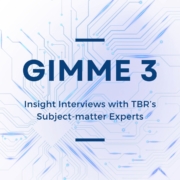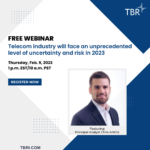Industrial IoT (IIoT) – Challenges in the marketplace
Gimme 3 — Insight Interview with TBR’s Subject-matter Experts
In TBR’s new blog series, “Gimme 3 — Insight Interview with TBR’s Subject-matter Experts,” Principal Analyst Patrick M. Heffernan discusses our latest and most popular research with our analyst team.
This month Patrick chats with Senior Analyst Evan Woollacott about Industrial IoT (IIoT), including how IT services vendors and consultancies must make smart choices around IP and ecosystems.
How vendors are grappling with ecosystems and IP challenges in the IIoT marketplace
Patrick: This line from TBR’s Digital Transformation Insights: IIoT Market Landscape really jumped out at me: “Perhaps victims of their own success, many IT services providers’ initial IIoT efforts sought to draw the OT [operational technology] and IoT ecosystem to their IP, when they should have used the ecosystem to draw their IP to the opportunity and customer environment.” Which IT services vendor stands out for having made that shift already? Which vendors use the ecosystem and their IP the right way?
Evan: Not to answer the question like a consultant, but, in short: too early to tell. Cloud platform leaders like Microsoft and Amazon Web Services (AWS) have certainly sought to build out their IIoT-enabling technologies at all levels of the IT stack, ranging from the OS layer with offerings like Azure Sphere or AWS FreeRTOS, to edge platforms like AWS Greengrass or Azure IoT Edge technologies for IIoT.
Atop this foundation, AWS and Microsoft have also each sought to allow clients to derive value from this newfound device-level data with their respective Cloud for Manufacturing portfolios, which should allow both companies to begin cultivating ISV ecosystems to optimize manufacturers’ discrete business processes.
That being said, Microsoft’s 2021 launch of Cloud for Manufacturing remains in public preview today, having missed its general availability target date of 3Q22. So, yes, IT services vendors and cloud hyperscalers have the technologies required to support clients’ IIoT aspirations, but the portfolios intended to deliver business outcomes, the Cloud for Manufacturing portfolios, remain in early-stage R&D.
This could be a result of the long list of tech standardization issues present in IIoT that may be delaying partner buy-in with not only familiar, IT-realm partners but also the vast OT end of the spectrum.
Patrick: In describing some common IIoT use cases, you say, “While these examples are not overly complex aspirations, the ecosystem design requirements to enable them inhibit an organization’s ability to scale the use case beyond just a single warehouse and/or the entire warehousing industry.” You also wrote that “no one client will use the same consortium of vendors across their IT and OT environments, a dynamic that — before even considering the rigorous regulatory and compliance laws of an industry like healthcare or pharmaceuticals — reinforces the need for technology standardization across the IIoT technology value chain.” Ecosystem design and evolving technology standards sound like huge consulting opportunities. Any consultancies that stand out as leading in IIoT?
Evan: At the top of the list, PwC’s Connected Solutions division probably has the potential to be an enabler of the IIoT market, relying heavily on its IT services and consulting expertise on manufacturing entities’ business processes, to build solutions atop Microsoft’s Azure.
As PwC identifies high-value solutions, the firm will gain the awareness of not only buyers but also Microsoft to encourage more solution codevelopment and insight into Microsoft’s own R&D road maps to ensure strong future alignment between the two firms. Though PwC’s DNA is professional services, this more ISV-led partner approach could provide lessons to PwC on how to develop solutions by leveraging Microsoft’s technology expertise. So, certainly PwC Connected Solutions is one to keep an eye on.
Patrick: You noted that “smart professional services vendors that recognize OT buyers are used to dealing with third-party suppliers will increase their focus on building relationships with the likes of Nokia, Bosch, Caterpillar and GE to ensure they have the ear of the OT buyer.” With all the other changes happening in services and technology alliance ecosystems, are you asking too much from the services vendors, by suggesting they broaden their ecosystem plays even further and manage even more alliances?
Evan: It is a lot to ask of IT services firms, no doubt, but this is what the clients will be asking as well. A client will be grappling with the need to manage their technology providers across both IT and OT realms as they pursue IIoT aspirations. I think it is important to recognize that the IIoT opportunity remains in its infancy today, with new use cases being found each day as clients harness additional data and discover ways of integrating it within their existing business processes to optimize their operations.
As more devices are connected, the needs around partner management will grow exponentially. To answer your question a different way, though, perhaps this all speaks to a need in the market, an opportunity for an IT services and consulting vendor to build its value proposition exclusively around IIoT. As we have said in various reports authored through TBR’s Digital Transformation practice, no one vendor can enable DT outcomes for clients.
IIoT is just a microcosm of DT, exclusive to asset and device-intensive customers with a seemingly never-ending list of use cases. Just as technology firms should never try to become service providers and vice versa, in the context of IIoT, maybe the Accentures of the world shouldn’t try to spread themselves too thin and cover this opportunity as well, but instead find the dedicated partner that has invested for years in its OT services resource bench to solve the IIoT market development issue together, not alone.
Well, Evan, tell us what you really think about how IT services vendors and consultancies should play in the IIoT space! A good point, honestly, and one that we make often in talking about the business of technology: Do what you do well and stick to it. Vendors that wander get lost. And readers, keep an eye out for an upcoming video with TBR Principal Analyst Bozhidar Hristov further discussing the topics Evan touched on in this blog.

 Technology Business Research, Inc.
Technology Business Research, Inc.
 Technology Business Research, Inc.
Technology Business Research, Inc. Elitsa Bakalova
Elitsa Bakalova
Leave a Reply
Want to join the discussion?Feel free to contribute!